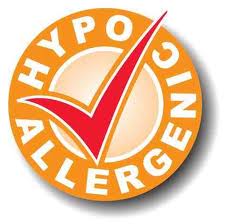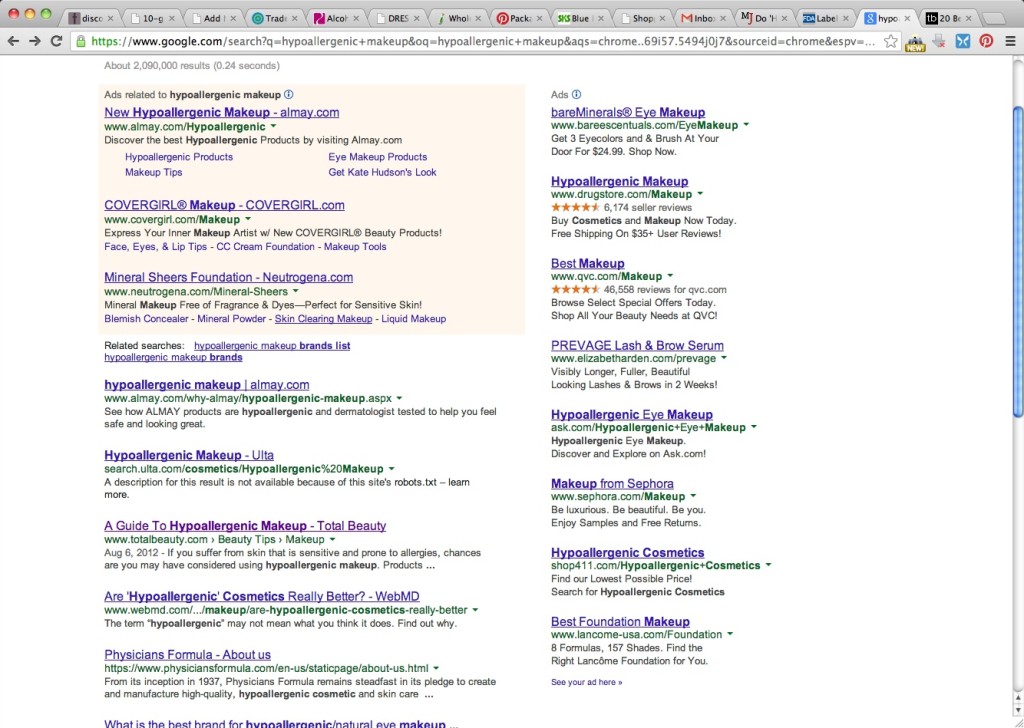We need to have a serious talk about getting wise to the way cosmetics are marketed to you, dear Friends. A number of Clients have asked me if the makeup I use is hypoallergenic, or warned me before application that they suffer from rosacea or eczema and as such can only use certain brands because their products are hypoallergenic and made specially for allergy sufferers and those with problem skin. What IS hypoallergenic makeup? (And what is in my kit that fits this description?)
The trouble is, there is no such thing as a cosmetic that is proven to never cause an allergic reaction in anyone ever. None. If there is, I’d hazard it might be made of unicorn horn dust and tested by faeries in lab coats.
The definition of the prefix -hypo means “less than normal; deficient”, so a hypoallergenic product is meant to contain “less than normal” levels of allergens. It does not mean that a product is guaranteed to never cause an allergic reaction, so it’s more important to learn how to read labels and identify ingredients you are allergic to instead of trusting a brand to know what’s best for you.
| hypo- or hyp-
pref.
1. Below; beneath; under: hypodermic.
2. Less than normal; deficient: hypoesthesia.
3. In the lowest state of oxidation: hypoxanthine.
[Greek hupo-, from hupo, under, beneath; see upo in Indo-European roots.]
|
The American Heritage® Dictionary of the English Language, Fourth Edition copyright ©2000 by Houghton Mifflin Company. Updated in 2009. Published by Houghton Mifflin Company. All rights reserved.
When did the use of the term become a part of the cosmetic lexicon? Back in February of 1974, the FDA proposed a regulation stating that a cosmetic could be labeled “hypoallergenic” only if scientific studies on human subjects showed that it caused a significantly lower rate of adverse skin reactions than similar products not making the claim. Cosmetic companies were required to conduct their own tests to back up their claims, but the US Court of Appeals for the District of Columbia struck down the attempts by the FDA and in late 1977 ruled the proposed regulations were invalid.
How did this come about? Well, Clinique and Almay, two major cosmetic companies that directly profited from selling themselves as hypoallergenic and continue to do so, lobbied and challenged saying that the FDA had no authority to issue the regulation. And they won.
So, who is responsible for substantiating the safety of cosmetics?
Companies and individuals who manufacture or market cosmetics have a legal responsibility to ensure the safety of their products. Neither the law nor FDA regulations require specific tests to demonstrate the safety of individual products or ingredients. The law also does not require cosmetic companies to share their safety information with FDA.
Read that again for yourself and let it sink in. “Neither the law nor the FDA regulations require specific tests to demonstrate the safety of individual products or ingredients.” The class of products that the FDA defines as cosmetics include deodorant, nail polish, hair color, permanent waves (which includes straightening products like the Japanese Straightening and Brazilian Keratin treatments), and eye or facial cleansers or makeups. That popular $7.49 eyeshadow palette at the drug store that’s labeled hypoallergenic that women with “sensitive eyes” scoop up?
These are the ingredients:
Mica, Boron Nitride, Dimethicone, Bismuth Oxychloride, Silica, Zinc Stearate, Polyethylene, Diisostearyl Malate, Polyglyceryl-4 Isostearate, Polymethyl Methacrylate, Nylon-12, Silica Silylate, Lauryl Methacrylate/Glycol Dimethacrylate Crosspolymer, Lecithin, Dimethiconol, Methicone, Lauryl PEG/PPG-18/18 Methicone, Phenoxyethanol, Sorbic Acid. May Contain: [+/-: Mica, Titanium Dioxide (CI 77891) (Bound), Bismuth Oxychloride (CI 77163), Iron Oxides (CI 77491, 77492, 77499), Ultramarines (CI 77007), Carmine (CI 75470), Chromium Oxide Greens (CI 77288), Ferric Ferrocyanide (CI 77510), Yellow 5 (CI 19140), Blue 1 (CI 42090), Red 40 (CI 16035), Manganese Violet (CI 77742)].
The ingredients in bold are linked to Livestrong articles (for the sake of consistency I included two articles from the same source, but there are numerous others out there) are known allergens. Bismuth Oxychloride is actually the most frequent cause of irritation for those who cannot use bare minerals powders. But the label still boasts that this product is hypoallergenic. A simple Google search for hypoallergenic makeup yielded an absurd amount of results.
Here is information on how the term is not remotely regulated, direct from the FDA’s own website.
The most recent statement from the FDA on the subject is from October 18, 2000 (also from the FDA’s website):
Hypoallergenic cosmetics are products that manufacturers claim produce fewer allergic reactions than other cosmetic products. Consumers with hypersensitive skin, and even those with “normal” skin, may be led to believe that these products will be gentler to their skin than non-hypoallergenic cosmetics.
There are no Federal standards or definitions that govern the use of the term “hypoallergenic.” The term means whatever a particular company wants it to mean. Manufacturers of cosmetics labeled as hypoallergenic are not required to submit substantiation of their hypoallergenicity claims to FDA.
The term “hypoallergenic” may have considerable market value in promoting cosmetic products to consumers on a retail basis, but dermatologists say it has very little meaning.
Don’t get suckered in by the label. It’s up to you to learn how to scan a label and recognize potential allergens that cause you irritation or break outs.
Shop with care, darlings–
Eden


